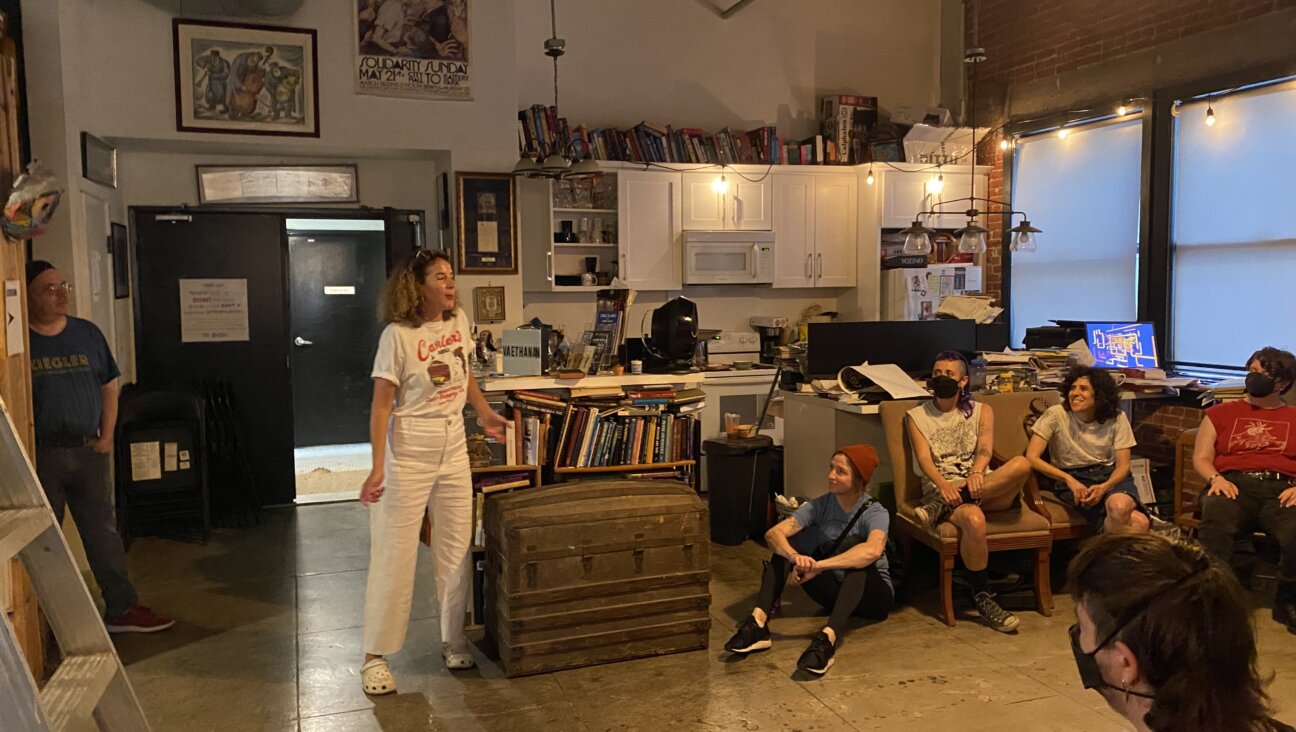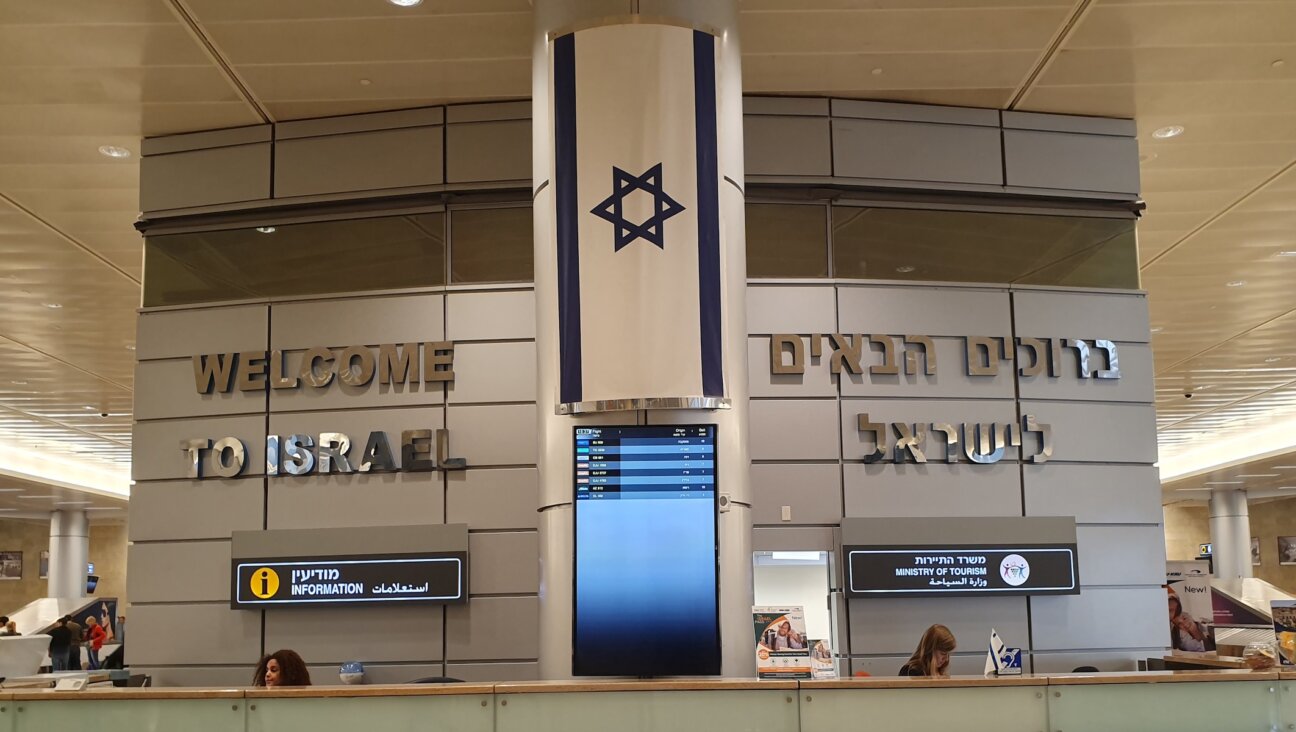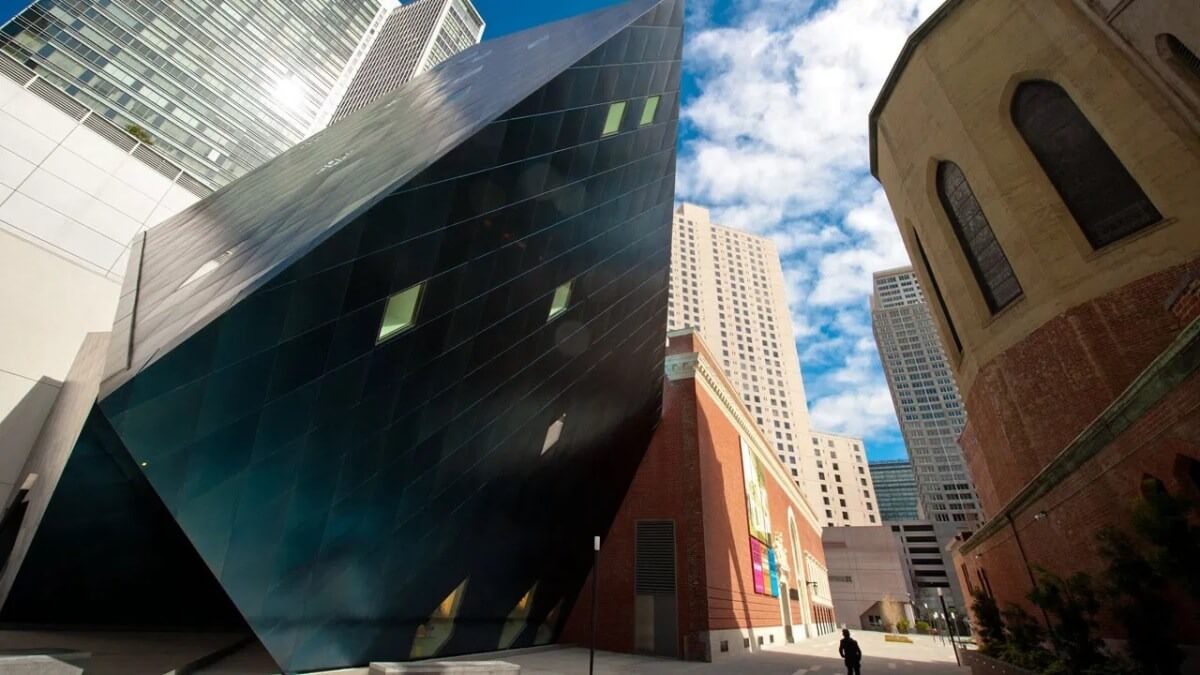Hunting the Graveyards for America’s Holiest Jews

New York Pilgrimage: Baruch Amsel writes a note at the grave of the Brownsviller Rebbe. Image by Sam Kestenbaum
The burial sites of the world’s great Jewish sages have served for centuries as spiritual magnets, drawing pious Jews on far-flung pilgrimages to pray in their presence.
Each Rosh Hashanah, the grave of Rabbi Nachman of Bratslav, the famed 18th century Hasidic master, draws tens of thousands of Hasidim to Uman, Ukraine. Likewise, the graves of Moroccan holy men like Rabbi Makhluf Ben-Yosef Abuhatzira, in the remote North African Draa Valley, attract thousands of Sephardic Jews.
My own foray into this tradition, though, took place near the multi-lane Jackie Robinson Parkway on the border of Brooklyn and Queens. There, in late September, as rush-hour traffic crawled by, a 39-year-old Hasid named Baruch Amsel introduced me to his own unique brand of spiritual quest.
High on a hill in Beth Olam Cemetery, the skyline of Manhattan in the distance, Amsel led me to the grave of Rabbi Israel Baer Kursheedt, a native of Frankfurt and star graduate of his yeshiva there, who arrived in America in 1796. Kursheedt was a pillar of New York’s Jewish community and had one of the largest collections of Jewish texts in America at the time. “This country was a spiritual wasteland when these men came,” Amsel said, referring to Jewish life in early America, when Kursheedt and other rabbinic pioneers immigrated. He looked at the horizon and then back to the gravestone, which has nearly grown smooth with age. “They built the foundations.”
Amsel is a real estate manager by profession — a cell phone, fastened to his belt, buzzes frequently — but his real work takes place only when he leaves behind the negotiations over maintenance fees and heating fuel contracts for the quest much closer to his heart. Amsel is a spiritual pilgrim, searching for the tombs of America’s Jewish sages.
For almost a decade, he has been identifying and memorializing the graves of North America’s great holy men, or tzaddikim. He has scoured the cemeteries in New York and surrounding states — from overgrown and forgotten sites to well-groomed, gated lots — and dug through archives and records across North America. Amsel, who grew up in Boro Park’s Hasidic enclave, said that before he started his project, many of these sites lay forgotten. “You could blow the dust off the graves,” he said. “No one was coming here.”
Today, devotees can find these sacred burial sites on Amsel’s website, Kevarim of Tzadikim—literally, “Graves of the Righteous”—in North America. The site is a project of the Institute for Judaic Culture and History, a not-for-profit organization he runs. The gravesites, or kevarim, Amsel has documented — more than 1,200 to date — dot the country, with nearly 700 clustered around New York.
In some traditions within Judaism, the graves of tzaddikim possess a unique kind of power. Prayers said at their side are endowed with a mystical force; Jews will journey to faraway lands in search of a tzaddik’s grave. Amsel’s goal is to show that such pilgrimages can be made closer to home.
Amsel grew up in a heavily Orthodox Brooklyn neighborhood — attending synagogue, praying, learning the stories of the biblical patriarchs — but he never thought that there were so many sacred sites in his own backyard. He studied accounting at Brooklyn College, got married and raised three children, and then one day a friend mentioned to him that the wife of the Chofetz Chaim, a revered rabbi in 19th- and 20th-century Poland, was buried in Queens. Amsel drove to the cemetery immediately. He had to see it with his own eyes.
There she was, Miriam Kagan, the rebbetzin, as rabbinic spouses are known, of the tzaddik, in Mount Judah Cemetery. This discovery lit the flame. Amsel began searching for other local kevarim. The process, at first, was tedious. “I walked up and down the roads,” Amsel said. He would stop at each graveyard. When his day job would bring him to new neighborhoods, he would take detours to local graveyards. Over time, he found hundreds of rabbis. They were immigrants, refugees and holy men.
Amsel knew of the grand burial sites of the Lubavitch and Satmar Hasidic dynasties, which have thousands of followers, but it was the more underappreciated figures that intrigued him: the Hasidic rebbes who presided over small synagogues in Brooklyn but left no followers, the rabbis who wrote talmudic commentaries while living in the American heartland. “If we don’t step up to the plate,” Amsel said, “they’ll be forgotten.”
There was Gershom Mendes Seixas, the spiritual leader of the country’s oldest synagogue, the Spanish and Portuguese Congregation Shearith Israel, and the Malach, the rebbe who split from Chabad and led a shul in the Bronx. Amsel found the onetime chief rabbi of Moscow buried in a forgotten corner of Queens, and an early rosh yeshiva, or dean, of Rabbi Isaac Elchanan Theological Seminary.
“People heard about me,” said Amsel, who now receives so many queries about this work that he limits the times he’ll take calls (his wife doesn’t like the phone at the dinner table). “They started sending in photos and names.”
As the scope of the project expanded, Amsel saw that the tzaddikim weren’t just in New York. He discovered them in Philadelphia, Georgia, Virginia, Colorado and Oregon. Anywhere Jews had gone,
Amsel discovered burial sites in Georgia, Virginia, Colorado and Oregon. Anywhere Jews had gone, there were revered rabbinic figures.
Amsel discovered, there were revered rabbinic figures. There was the Atlanta-based rabbi who certified Coca-Cola as kosher; Jewish pioneers buried in Bangor, Maine, and Bennington, Vermont, and the chief rabbi of Wisconsin.
Amsel leads tours to gravesites like this and includes directions on his site. This is all free of charge and he has no major funding to support the work. (The only banner advertisement on the website is for a Judaica auctioning house, run by his father.)
Some of the graves were easy to track down; others took ages. Amsel searched for seven years for the grave of a 19th-century scholar named Rabbi Joshua Falk, who wrote the first original Hebrew book in the United States, “Avnei Yehoshua,” a commentary on Pirkei Avot.
This is what Amsel knew: Falk died in Iowa while visiting a daughter, but had arranged to be buried in New York. Amsel combed the records; he narrowed the search to two graveyards, then eliminated one of those two. He was convinced the rabbi was buried in one of New York’s oldest cemeteries, but there was a catch: Here, the gravestones were made of limestone; the letters had worn away with age, leaving undecipherable whispers of the names. Even though he had a small team of volunteers helping him with research now, the search was impossible. “The tracks went cold,” Amsel said.
Then, this year, they stumbled on the tzaddik’s grave. Literally.
On a routine tour, one of the volunteers lost his footing and tumbled to the ground. As he raised his body, he looked up and saw the name they’d spent years looking for: Falk. The grave was hidden in plain sight, in Salem Fields Cemetery, straddling the boroughs of Queens and Brooklyn. “We’d been there so many times,” Amsel said.
Falk’s name was scratched off the list of “cold cases,” but he said there are dozens more: “There are still outstanding mysteries.” Amsel and I climbed down the hill, passing other graves piled with small stones. He wore loose dress pants and a white shirt that billowed around him in the breeze; wispy side curls were tucked behind his ears.
Amsel had originally wanted to publish a book on his findings, but the project was simply too sprawling. He decided on a website, which he could update as he learned more. “People have tried to do this before,” Amsel said, noting that there have been past projects to map the burial sites of Jewish religious figures in America. “But they never had access to the Internet. Now we’re able to do much more.”
Kevarim.com became a meeting point for like-minded history buffs, sometimes even relatives of the sages, who shared their findings: tips on a grave’s location, links to hard-to-find Hebrew and Yiddish texts, or scans of faded photos. Website commenters frequently correct Amsel or each other, providing differing biographies, or supporting sources. Eight years after it was launched, the site gets around 400 hits a day; visitors can scroll through more than 40 pages of holy men.
Amsel led me to Union Field Cemetery and pointed to a grave near a tall, gnarled tree. A candle box was propped at the foot of the tombstone, handwritten letters stuffed between cracks in the stone. This, Amsel explained, is the site of Rabbi Jacob Joseph, the first chief rabbi of New York City.
In the 1880s, the city’s Jewish communities were diverse and fractured. There were socialist Jews, Litvaks, small pockets of Hasidim and other growing denominations. One group of Lithuanian Jews banded together to find a learned rabbi from Europe to lead them.
Without unity, the group wrote at the time, “there is no hope for the preservation and upbuilding of Judaism in our city.” In 1888, the Association of American Orthodox Hebrew Congregations brought Joseph, a revered Vilna cleric, to be their chief rabbi. Like many of the first generation of rabbinic figures, Joseph came, in part, because of economic hardship. He was in debt in Europe, and the Orthodox congregations offered to pay it off.
While popular at first, Joseph was ultimately a failure as a chief rabbi. There was too much resistance (some, like a rival Hasidic rabbi, publicly disputed his use of the title “chief rabbi”), and eventually he even lost the financial support of the Orthodox congregations.
Still, Joseph did briefly become a public face for religious American Jewry. In the New York Herald he explained what he believed Jews wanted: to “become like other citizens of the country,” but still “walk in the ways of Your holy Torah, without being ashamed of anything.”
As we were leaving the grave, Amsel confided in me: It’s his own distance from these sages, an awareness of how different his life is from theirs, that moves him. His immigrant grandparents, and the rabbis he tracks down, did not know the comfort that Jews have now, he said, the freedom they have to live religiously: “We take it for granted.”
Amsel has no problem finding kosher food near his job; he can find a minyan with little effort. “It wasn’t always the way we see it. My grandfather didn’t have that when he came to this country,” he said.
Can these rabbis measure up to the tzaddikim of the distant past? “I think about that all of the time,” Amsel said. “And who am I to judge?” This is what he knows: “These rabbis gave their lives to lay those foundations. If not for them, we’d have nothing. Unfortunately, we forgot about them. Anyone who came to this country and dedicated his time and life to other people, to making America more Jewish, I would say is a holy person.”
Amsel quoted from the Talmud, “Jeptath in his generation was like Samuel in his,” a passage also intoned in an email exchange with Rabbi Avi Shafran, spokesman for the Haredi organization Agudath Israel of America. “While it is a recognized truth that each generation, being farther removed in time from Sinai, cannot fully measure up to previous ones, we are to revere the great people of our own time,” Shafran wrote. “It makes no difference whether great men and women of one generation measure up to those of previous ones. They are great for their times — indeed, God guides each generation by providing great people in each era who are best for that era.”
But the question of who qualifies as a tzaddik, and whose name will be uploaded to the site, can sometimes be complicated. Occasionally Amsel will add a name and readers will object — if, for instance, it emerges that the figure in question never earned his rabbinic ordination. (Amsel also once had to remove a rabbi who had been jailed for financial fraud.) “If there is negative feedback,” Amsel said, “I’ll dig deeper.”
He outlines more specific criteria on his site. He is interested in Orthodox Jewish figures who “made major contributions to Yiddishkeit as we know it today,” he said, using a Yiddish word for “Jewish way of life” and is often used to mean Orthodox Judaism. “I’d like to do a similar site for Reform and Conservative movements; the history fascinates me,” he said, but he hasn’t found any collaborators. “The Orthodox is a world I know more about. It’s the fold I’m from.”
We made our way to Mount Judah Cemetery, another one of the series of Jewish graveyards that lie off the Jackie Robinson. Here, Amsel wanted to show me a duo that is particularly close to his heart: two of the first Hasidic rebbes to teach in America, a father and his son.
Like all Hasidim, Rabbi Eliezer Chaim Rabinowitz was carrying on the tradition of the Baal Shem Tov, the Master of the Good Name, the mystic patriarch of the Hasidic movement. At the turn of the 20th century, Rabinowitz was one of the first Hasidic leaders to come to America. Followers in New York City called him the Yampole Rebbe.
Then, Hasidism had yet to find a foothold in this country, and the popular movement from Europe made some American Jews uncomfortable. The editor of the traditional Jewish newspaper American Hebrew warned readers to “exert the fullest influence possible to discountenance the transplanting of this system to this country.”
But in the next decades, Hasidism would not just transplant, it would take root and blossom. The Yampole’s son, Rabbi Shmuel Avroham Rabinowitz, was another pioneer who led one of the country’s first Hasidic courts, at 770 Howard Avenue, in Brooklyn. Followers called him the “Brownsviller,” and in the days leading to Yom Kippur he would receive thousands of requests for blessings.
This father and son are the sorts of figures to which some Litvak Jews had objected. The rabbis on Amsel’s list represent different strains and traditions, like Sephardim, Litvaks and Hasidim. “They lie together in the same cemeteries,” said Jonathan Sarna, a professor of American Jewish history at Brandeis University, describing the variety of early American Jewish Orthodoxy. “What unites them is their desire to build a Jewish tradition in America, to create a vibrant American Jewish community.”
The visitors who Amsel guides are interested in Jewish history, yes, but it isn’t idle curiosity that draws people here; they come looking for solace. “The average person who comes is someone who has trouble,” Amsel said. “They’re looking for something, they’re missing something.”
Years ago, Amsel remembers making solo treks to these rabbis’ graves when no one came here. “In the old days, I would have to set a candle in a soda bottle,” he said. Now there are metal boxes dotting the cemeteries, used to hold memorial flames. “There is more awareness; people are coming more and more.”
Amsel doesn’t pray each time he is in the field. Sometimes he’s only out to gather new photos for the site or to investigate a lead. But he paused at the younger Rabinowitz’s grave. “It’s his yahrzeit,” Amsel said quietly to himself, as if he just remembered.
He rummaged in his trunk for candles, handed one to me, and lit his in a flame-blackened box at the foot of the tombstone. Three other candles flickered inside next to a pile of spent matches. Amsel was quiet as he wrote on a thin sheet of paper. Dozens of other notes, left by other pilgrims, fluttered in the breeze. An elevated train rolled by in the distance.
“We’re talking with the person’s essence,” Amsel said after he had carefully tucked his own note beside the others. “We’re pouring out our hearts to God, and this is a way to do it.”
Contact Sam Kestenbaum on Twitter @skestenbaum
A message from our CEO & publisher Rachel Fishman Feddersen

I hope you appreciated this article. Before you go, I’d like to ask you to please support the Forward’s award-winning, nonprofit journalism during this critical time.
At a time when other newsrooms are closing or cutting back, the Forward has removed its paywall and invested additional resources to report on the ground from Israel and around the U.S. on the impact of the war, rising antisemitism and polarized discourse.
Readers like you make it all possible. Support our work by becoming a Forward Member and connect with our journalism and your community.
— Rachel Fishman Feddersen, Publisher and CEO























